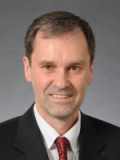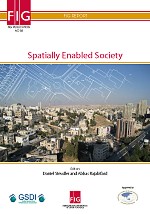FIG Task Force on Spatially Enabled Societies

|
FIG Task Force on Spatially Enabled Societies 2009-2012
In May 2009, the FIG General Assembly
established in Eilat the short term Task Force (2009-2012) with the aim to
explore the issue of Spatially Enabled Societies (SES) from a cadastral and
surveyor’s point of view. The purpose was to identify the role of the
profession, how it can provide for a spatially enabled society and to make
recommendations.

The Task Force identified six key elements, which are
critical to the implementation of a Spatially Enabled Society. Without those six
elements, the spatial enablement of a society or government would seriously be
held back in its progress. They are:
-
Legal framework: to provide a stable basis for the
acquisition, management, and distribution of geographic information;
-
Common data integration concept: to facilitate
that existing geographic information – from government as well as other
sources – respect a common standard in order to ensure interoperability and
linkage of data for the benefit of all;
-
Positioning infrastructure: to provide a common
geodetic reference framework in order to enable the integration of
geographic information;
-
Spatial data infrastructure: to provide the
physical and technical infrastructure for geographic information to be
shared and distributed;
-
Landownership information: to provide updated and
correct documentation on the ownership and tenure of the land, fisheries,
and forests, without which spatial planning, monitoring, and sound land
development and management cannot take place;
-
Data and information concepts: to respect and
accommodate the different developments in the acquisition and use of
geographic information.
Publication
Executive Summary
The needs of societies are increasingly of global scale and require spatial
data and information about their land, water and other resources – on and under
ground – in order to monitor, plan, and manage them in sustainable ways. Spatial
data and information, land administration, land management, and land governance
play crucial roles in this.
Spatial enablement is a concept that adds location to existing information,
thereby unlocking the wealth of existing knowledge about land and water, its
legal and economical situation, its resources, access, and potential use and
hazards. Societies and their governments need to become spatially enabled in
order to have the right tools and information at hand to take the right
decisions. SES – including its government – is one that makes use and benefits
from a wide array of spatial data, information, and services as a means to
organize its land and water related activities.
This publication focuses essentially on six fundamental elements, which are
required to realize the vision of a SES:
- a legal framework to provide the institutional structure for data
sharing, discovery, and access;
- a sound data integration concept to ensure multi-sourced data
integration and interoperability;
- a positioning infrastructure to enable and benefit from precise
positioning possibilities;
- a spatial data infrastructure to facilitate data sharing, to reduce
duplication and to link data producers, providers and value adders to data
users based on a common goal of data sharing;
- land ownership information, as the dominant issue in the interactions
between government, businesses and citizens relating to land and water
resources;
and
- data and information to respect certain basic principles and to increase
the availability and interoperability of free to re-use spatial data from
different actors and sectors.
Land and spatial information professionals play a primary role in translating
raw data into useable spatial knowledge resources. These professions should
ensure that both the social and technical systems in which spatial enablement
will operate within are well understood. Spatial enablement can only be
effective when it is designed with the specific needs of the jurisdiction in
mind.
The concept of SES is offering new opportunities for government and the wider
society, but it needs to move beyond the current tendency for the responsibility
to achieve SES to lie solely with governments. SES will be more readily achieved
by increasing involvement from the private sector, and in the same vein, if the
surveying and spatial industries start to look toward other industries for best
practices in service delivery.
Future activities need to take into account emerging trends in spatial
information and the new opportunities they present for the application of
spatial technologies and geographic information. These trends include among
others:
- location as the fourth element of decision-making;
- differentiating between authoritative and volunteered information, yet
recognizing
the importance and value of both types of information towards spatial
enablement and the enrichment of societies;
- growing awareness for openness of data e.g. licensing, and resultant
improvements
in data quality;
- move towards service provision.
Presentation and publication
-
Presentation at FIG-Working Week, Rome, Italy, May 2012.
-
Final Report to General Assembly, Rome, May 2012.
-
Expert Group Meeting at the
"UNRCC–PCGIAP
International Symposium on Spatially Enabled Government and Society"
in Kuala Lumpur, Feb. 2012, resulting in the «Kuala
Lumpur Declaration on Spatially Enabled Government & Society»
-
Paper
and
Presentation at FIG-Working Week 2011, Marrakech, Morocco, May 2011.
-
Paper and
Presentation at FIG Congress, Sydney, Australia, April 2010.
-
Report to the General Assembly, Sydney, April 2010
Contacts
|
 |
Dr. Daniel Steudler
Swiss Federal Directorate for Cadastral
Surveying
Seftigenstrasse 264
CH-3084 Wabern
SWITZERLAND
Tel. +41-31-963 2482
Email:
Daniel.Steudler@swisstopo.ch |
|

























